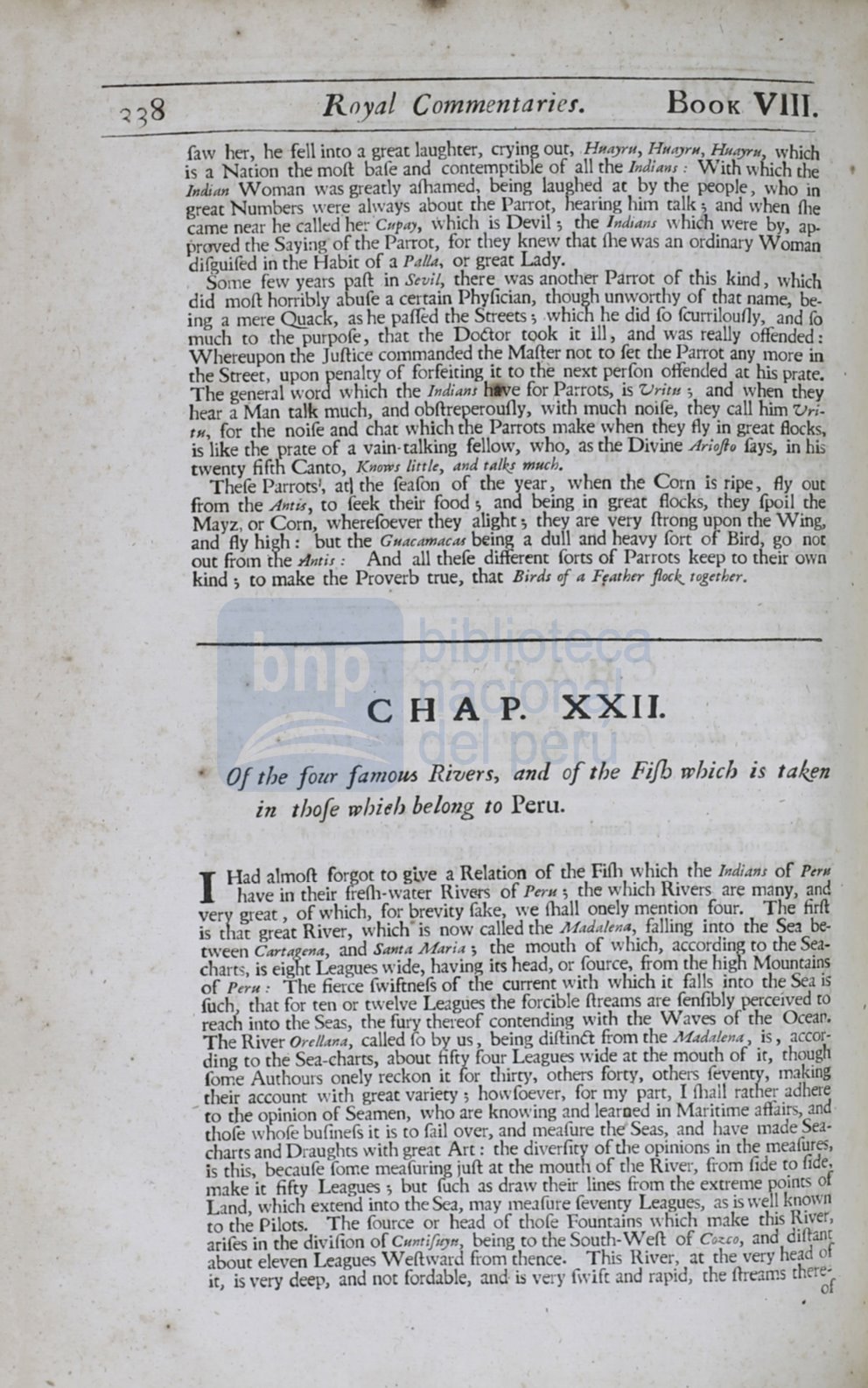

,
I
· R~yal
Commentaries.
BooK
VIII.
faw her, he fell into a great laughter, crying out,
Hnayru,
H11ayrH,
HJtayrit
which
is a Nation the mofi bafe and
contemp~ble
of all the
Indians :
With
whlch
the
lndi.anWoman was greatly a
fhamed, being laughed
at
by the people who in
great Numbers were
ah
ays
ab.cu~ch~ Parr~t,
hearing
him
talk;
and
~hen
fhe
came near he
called
he
Cupay,
whICh
IS
Devil ; the
Indians
which
were by
a _
proved the Saying of the Parrot, for they knew that fhe
was
an ordinary
W~mfn
difguifed in the Habit of
a
Palla,
or great Lady.
Some few years
pafl:
in
Sevil,
there was another Parrot of this kind
which
did
mofi
horribly abufe
a
certain Phyfician, though unworthy of that
na~~
be–
ing a mere Qg_ack, as he
pa!fed
the Streets; which he did fo fcurriloully
and fo
much to the purpofe, that the Dotter took it
ill,
and
was
really offended .
Whereupon the
J ufiice commanded the Maller not to fer tbe Parrot
any
more
~
the Street, upon
penal.tyof forfei.ting it to the next
pe~fon
offended at
his
prate.
.
The generJl word whICh che
lndums
h
e
for
Parrots,
IS
Vritu;
and when they
hear
a
Man talk much, and obfireperoufly, with much noife, they call
him
Vri–
tH,
for
the noife
and
chat which the Parrots make
when
they fly
in
great flocks,
is
like the prate of a vain-talking fellow, who,
as
the
Divine
Ariofto
fays
in
his
twenty
fifth
Canto,
Knows little, and talk! much.
'
Thefe Parrots
1,
at) the feafon of the year,
when
the
Corn
is
ripe,
By
ouc
from the
Antu,
to feek their food ; and being in great flocks, they
f
poil
the
Mayz,
or.Corn, wherefoever they
ali~ht;
they are very firong upon the
Wing,
and
fly
high :
but the
GuacamacM
bemg
a dull and heavy fort of
Bird,
go
not
out from the
Antis :
And
all
thefe different
forts
of Parrots keep to their
own
kind ;
to
make the
Proverb
true, that
Birds of a
Ff1tther
flock._ together.
CH AP.
XXII.
Of
the four
famo~
Rivers, and
of
the Fijb
which
1s
tal<._en
in
thofe
whieb
belong
to
Peru.
I
Had
almoft forgot
to
give
a
Relation
of
the
Filli
which the
Indians
of
PerH
have in their fre(h-wacer Riv&s of
PerH;
the which Rivers are many, and
very great, of which,
for
brevity fake,
we fhall
onely mention four. The
firft
is
that great River, which is now called the
Madalena,
falling into the Sea
be–
tween
Cartagena,
and
Santa Maria;
the mouth
of
which, according to the
Sea–
char ,
is
eight
Leagues
wide, having its head, or fource, from the
high
Mountains
of
Peru :
The fierce
f
wifmefs of the current with which
it
falls
into the
Sea
is
fuch
1
that
for
ten
or
twelve Leagues the forcible fireams are fenfibly
~rceived
to
reacn into the eas, the fury thereof contending with the Waves of rhe Ocean.
The River
Orellana,
called
fo
by us, being dillinct from the
Madalena ,
is,
accor~
ding to the Sea-charts, about
fifty
four Leagues wide at the mouch of
it,
though
fome Aurhours onely reckon it for thirty, ethers forty, others fevency, making
their account
with
great variety; howfoever, for my part,
I fhall
rather adhere
to
the opinion of Seamen, who are knov. ing and learned in Maritime affair ,
and
chofe \ hofe buGnefS it is to
fail
over, and meafure the Seas,
and ha
e made
Sea–
charcs and D raughts with
great
Art : the diverfity of the opinions in the
meafures,
is this, becaufe fome meaforing jufi: at the month of the River, from fide to
fide
make
it
fifty Leagues;
but
fuch as draw their
lines from
the extreme pointS of
Land, which extend into the
Sea,
may meJfure fevenry League , as is \.Vell
knm n
to
the Pilots. The fource or head of thofe Fountains
\\·hich
make
chis
River,
arifes in the di ilion of
Cuntif
ttyn,
being to the South-Weft of
Co~co,
and dillant
about eleven Leagues
Wdhvard
from thence.
This
River, at the very
head of
it,
is
very
deep,
and not
fordable,
and
is
very
fidft
nd
ra
id,
the
fueams
cher~f














